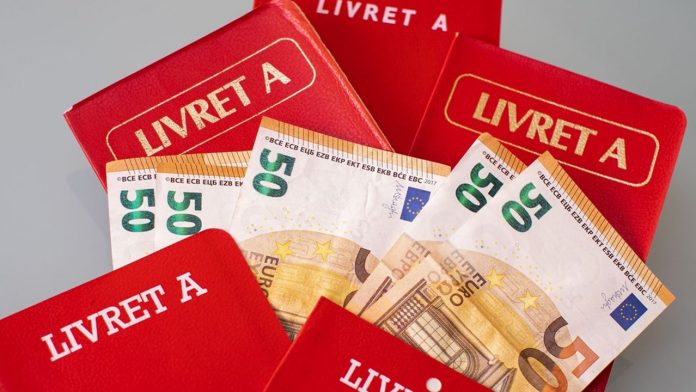Posted Oct 4, 2022, 6:45 AM
Savers’ hopes were dashed. In mid-October, the Banque de France will not propose to the Minister of the Economy to increase the remuneration of the Livret A to the 1er November, learnedThe Parisian . As authorized by the regulations, the monetary institution could indeed have taken such a decision in order to pass on the inflation which is still rife in the euro zone. In France, in September, consumer prices rose 5.6% over one year, according to the provisional estimate of INSEE.
1. Why did the Banque de France decide to block the remuneration of the Livret A?
“This intermediate revaluation is not an obligation but a possibility”, recalls the Banque de France. Questioned, she justifies the absence of a boost to 1er November by the significant increase that occurred this summer . “The increase in early August was significant in supporting the remuneration of savers in the face of rising prices, while preserving the financing of social housing”, indicates the monetary institution. The Livret A rate was then increased from 1 to 2%.
This doubling was accompanied by strong inflows. In August, savers paid 4.49 billion euros net into their Livret A savings account, i.e. almost 3 times more than in August 2021. Investors are turning in particular to the regulated savings account, which has become a better bidder than most euro funds in their life insurance policy.
Contrasting with the plebiscite of the Livret A, the supports in euros have seen their outstandings melt by 12.4 billion euros since the beginning of the year, including -1.8 billion euros in the month of August alone, can we retain from the balance sheet released at the end of August by France Assureurs.
2. How is the Livret A rate calculated?
Except in exceptional circumstances, therefore allowing liberties to be taken with the rule, the Banque de France calculates the Livret A rate twice a year, on 15 January and 15 July for entry into force on 1er February and 1er august. His remuneration is the result of the average between inflation in France and short-term interbank rates.
Specifically, the inflation parameter is measured by the half-yearly average of the variation in the consumer price index excluding tobacco on an annual basis. With regard to interbank rates, the Banque de France uses the half-yearly average of the €STR, the successor to Eonia. And, at a minimum, the Livret A rate cannot fall below 0.50%.
The Banque de France “transmits the result of the calculation within four working days to the Director General of the Treasury”, provides the decree framing the setting of interest rates for regulated savings products. Then, “when the result of the calculation leads to a change in the rates, the Director General of the Treasury has the new rates published at the Official newspaper of the French Republic”, continues the decree.
Since the start of the year, strict application of this rule has led to the Livret A rate being raised twice. It was 0.50% on 1er last January, before being raised to 1% on 1er February then to go to 2% on the 1er last August.
This remuneration, which has quadrupled in a few months, is to be attributed to the inflationary surge triggered in the summer of 2021 and exacerbated by the war in Ukraine. The €STR remained rather stable. It is only since the end of July and the start of the European Central Bank’s key interest rate hike that this interbank indicator has also risen. In negative territory until mid-September, it now peaks at more than 0.6%.
3. Why are savers not yet seeing the effect of the interest rate increase?
Savers connecting to their personal banking space do not yet see the effect of the rise in interest rates on the outstanding amount of their Livret A. This is not an error on the part of the banks. They only follow the operating rules specified in the monetary and financial code.
In fact, interest generated by savings on Livret A savings accounts is credited to them only once a year, on 31 December. This means that the nearly 24 billion additional euros paid by the French into their Livret A since the beginning of the year are indeed “working”, but the gains generated will only be visible and added to the outstanding booklets until the end of the year.
4. How is the remuneration of the other booklets changing?
To separate their precautionary savings from their bank account, the Livret A is not the only accessible medium. In addition, French people can open a Sustainable and Solidarity Development Booklet (LDDS) whose rate is identical to that of the Livret A. The rate of the LDDS will therefore not be reassessed until the remuneration of the Livret A is not either. .
Those under 25 have their own regulated rate support: this is the Livret Jeune whose remuneration cannot fall below that of the Livret A. If the banks therefore have the possibility of serving a rate higher than 2% to their young customers, few establishments exceed this minimum level.
Households with modest incomes – a single person in mainland France must this year justify a tax reference income of less than 20,297 euros – have access, for their part, to a super Livret A: the Livret d’épargne populaire. This LEP must at least be remunerated at the level of Livret A plus half a point. But in the event of high inflation, his remuneration is equal to the half-yearly average of the consumer price index excluding tobacco. This is the reason why its rate was raised to 4.6% on 1er august.
Alongside these savings accounts, the rate of which depends on parameters codified by law, banks can offer their own savings accounts. In this case, the interest is taxed. Since the raising of the Livret A rate, and more generally since the rise in interest rates, the remuneration of bank books has experienced a slight jump.
Excluding the promotional offer, the base rates for PSA Banque and Cashbee savings accounts were increased to 0.70% between the end of June and the beginning of July, compared to 0.50% and 0.60% respectively previously. Another recent example, Crédit Agricole’s online bank, BforBank, increased this 1er October to 0.20% the remuneration of its booklet, against 0.05% previously. The yields of these taxed savings accounts are still very far from those served on regulated savings accounts.
5. What to expect for 2023?
Many booklets follow the performance of the Livret A. If the latter will not change on 1er November, the Banque de France is already warning that there will indeed be an increase in its remuneration at the start of 2023. “There will be, in accordance with the texts, a new increase next February”, thus indicated on October 3 the Banque de France.
If the levels of inflation and interbank rates are maintained, the Livret A rate could be raised by one point, or even a little more, to around 3%. It would be the same for the LDDS and for the base rate of the Livret Jeune.
On the other hand, given the continuation of inflation, the only determining parameter for the LEP, the popular savings account rate could be raised to around 6% at the beginning of February.













